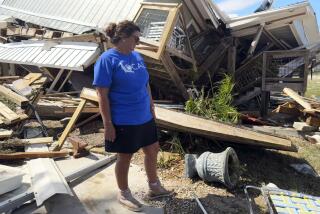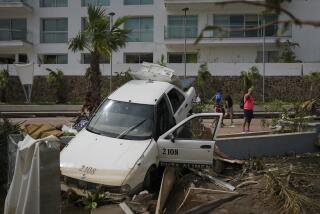Honduras Lives With Legacy of Hurricane Mitch
TEGUCIGALPA, Honduras — It no longer takes a hurricane like Mitch to bring Honduras to its knees. Less than an inch of rain is enough to make silt-filled rivers rise to dangerous levels and clogged drains flood downtown streets in knee-deep water.
Hurricane Mitch pounded Central America for nine days a year ago, from Oct. 25 to Nov. 2, killing nearly 10,000 people, leaving at least 2 million homeless and causing damage estimated at $10 billion. In Honduras alone, 5,657 people died and more than 220,000 houses were destroyed.
Although Honduras is no longer in a state of crisis, the lengthy process of reconstruction and the fundamental changes necessary to prevent another such tragedy are only just beginning, aid organizations and government officials say.
“When Mitch came, we weren’t even prepared to warn anyone,” said Arturo Corrales, director of Honduras’ recently overhauled national emergency response agency, COPECO. “What we can do now is warn people longer in advance, but what we can’t do yet is prevent these things from happening.”
Evidence abounds in the capital of Tegucigalpa and throughout the country that there is much work to do. Mitch left already inadequate drainage systems more clogged and broken than ever. Some drains force water back into the streets instead of letting it out into rivers.
Major bridges have not been replaced and tons of silt deposited by the storm have not been removed, elevating rivers to higher-than-normal levels that leave them much more vulnerable to flooding.
Some 12,000 people still live in “risk zones” in Tegucigalpa--low-lying areas and unstable hillsides that weren’t safe before Mitch and are even more dangerous because of it.
Instruments that measure land movement indicate many populated hillsides could come down easily in a heavy rain, the U.N. Development Program says.
“This is going to be a significant problem during the rainy season for the next few years,” said Diego Beltrand, head of the International Migration Organization in Honduras.
Moises Starkman, minister of international cooperation, said replacing wrecked roads, bridges, drains and other infrastructure and eliminating the risk of future disasters is a daunting task for this impoverished nation.
The Honduran government already has spent $14 million-- equivalent to half the military’s annual budget--just on dredging rivers, Starkman said. But with declining coffee and banana exports, the government has few resources.
Starkman said Japan’s government has promised to donate bulldozers to help with more dredging next year, “but clearly those machines will not be enough.”
A three-year program to replace Honduras’ 21 major bridges will begin next year, while houses for people who lost theirs to the storm are being built across the country, Starkman said.
Work to rebuild more than 100 small bridges and hundreds of roads--financed by $60 million in loans and $50 million in grants from various countries and organizations--should begin in the next few months, he said.
Representatives of donor countries meeting in May reaffirmed pledges of $2.7 billion in grants and loans to help Honduras rebuild. Contracts for 82 projects worth $596 million have already been signed, Starkman said.
“People were saying that we lost an infrastructure that took four, five, six decades to build. They said it would take decades for us to recuperate,” he said. “I, for one, will say that within two or three years, we will see Honduras to a large extent as we were before, and in some areas even better than we were before Mitch.”
Negotiations with donor countries and financial institutions like the World Bank began last December, soon after Mitch, and have produced commitments more rapidly than officials expected.
“People say it has to be faster, but what do they compare it with-- with how Honduras used to work before, or what they do in Europe and the United States?” Starkman said. “It takes longer. It takes time.”
Even so, most donors require that aid be spent within two years, which officials say is not nearly enough time to carry out long-term development projects.
COPECO is better equipped now to foresee and manage disasters because of a bigger staff and better operating strategies, says its new director, Corrales.
When the country was hit by heavy rains in late September and early October, for instance, Corrales was able to impose a state of alert based on satellite pictures showing a giant storm system headed for Honduras.
Although the storm lingered only briefly before moving on to Mexico, it caused substantial flooding in Honduras, killing at least 29 people and sending more than 9,000 to temporary shelters, the Red Cross said.
“It would have been a lot worse without the warning,” Corrales said.
But COPECO’s most important and challenging goal of preventing disasters is going to take a lot longer.
The process involves not only a broad analysis of the damage Mitch caused--how it changed the course of rivers, for example--but also an attack on the chronic problems of poverty and poor development that made Honduras susceptible to widespread devastation in the first place.
“We’re talking about changing the culture of poverty, educating people and making them full participants in the process,” Corrales said.
Widespread deforestation led to landslides, and poor education and training left local governments and populations ill prepared to help themselves in the emergency.
Some aid officials say aid groups and ordinary people from around the world who responded by the thousands to help Mitch’s victims unwittingly contributed to the problems with such projects as new housing developments that lack running water and electricity.
Mike Giles, a top CARE official in Honduras, blamed the government for the problem, saying that there was “a complete lack of coordination” and that some of the aid was used by agencies unequipped to handle it.
But Starkman said that was the intention of the administration of President Carlos Flores Facusse. It wanted to avoid bottlenecks of relief supplies and accusations that the government was misusing the money, and made “no attempt at all” to control the aid, Starkman said.
Despite the long road ahead, Starkman said things could be worse.
“Observers said we were going to have famine, all types of epidemics, that the lempira [currency] was going to be devalued tremendously . . . and that we were going to have civil disturbances,” he said. “I think if we look at how we were then and how we are now, we did better than almost anybody in Honduras thought.”
More to Read
Sign up for Essential California
The most important California stories and recommendations in your inbox every morning.
You may occasionally receive promotional content from the Los Angeles Times.










